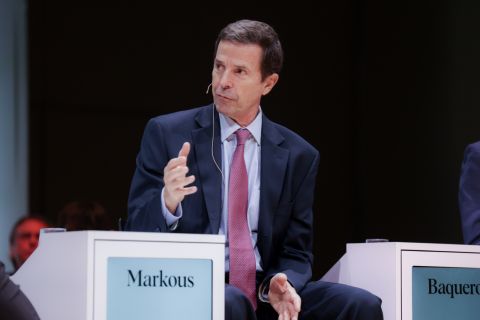
Bankruptcies in the U.S. oil and gas industry have been rising. (Source: Hart Energy; Shutterstock.com)
[Editor’s note: Opinions expressed by the author are their own.]
It is less than two months since Donald Trump travelled to Texas to declare that the U.S. energy industry, laid low by this year’s oil price crash, was back on its feet. “We’re OK now,” the president told the assembled crowd.
But bankruptcy numbers released this week tell a different story. Another 16 upstream US oil and gas companies—producers and service providers—hit the wall in August, the same number as in July, according to law firm Haynes and Boone.
Bigger drillers such as Chaparral Energy Inc. and Valaris Plc have joined a pile-up that has seen companies with a combined $85 billion worth of debt file for protection from creditors over the past eight months.
“We’re continuing to see a steady stream of oil and gas producer bankruptcies and oilfield service bankruptcies. And we do not anticipate any immediate interruption in that steady stream, especially on the oilfield service side,” said Charles Beckham, a partner at Haynes and Boone.
If oil prices stay around current levels—with U.S. marker WTI trading in the region of $40/bbl—the number of operators expected to file for Chapter 11 by the end of 2022 could hit almost 190, according to Rystad Energy, a consultancy. That would be on a par with the total number of casualties over the five years to 2019.
The country’s oil sector was battered in the early months of the coronavirus pandemic, which sapped global consumption by as much as a third, just as a surge in Saudi Arabian output left the market oversupplied. Prices collapsed, with the U.S. benchmark turning negative in April for the first time.
That left U.S. producers slashing production as they scrambled to cut costs. For the services groups that provide producers with muscle and knowhow, it was even worse: work dried up to a trickle.
Prices have since recovered some ground but the industry is still hurting. And the wave of bankruptcies was set to continue, Beckham said, with the rate of filings in the services sector, in particular, set for a “marked increase” over the coming months.
“It’s a downward spiral,” said Beckham. “If no one is using their services, it is very difficult for them to continue to be viable in terms of liquidity and having new business coming to the door.”
The oil industry is no stranger to downturns. This time, however, debtholders’ losses could be serious. Rating agency Moody’s reckons investors’ recoveries on defaulted debt will be somewhere between the levels of 2015 (21%) and 2016 (50%). That is much lower than the historic average of 58% since 1987.
“Lack of capital is problematic. Lack of investor interest is problematic. And an excess amount of distressed assets is problematic,” said Moody’s analyst Amol Joshi. “That’s why we expect more below-normal recoveries in this cycle.”
Moreover, as companies come through the other side of bankruptcies, they will be emerging into a different world. Much has changed—and they are going to have a tougher time accessing capital.
“Investors aren’t willing to take the same risks as before because the outlook has changed,” said Andrew Gillick, a managing director at RS Energy Group. Five years ago, the market was expecting higher oil prices and strong mergers and acquisitions activity, while environmental, social and governance considerations were a “European focus”, he said.
“Today that’s changed,” Gillick added. “Prices are lower, M&A is dead and ESG is here.”
Many investors—burnt by defaults in the previous downturn—are fed up with the sector. From credit investors and banks to equity investors, there is a reluctance to throw good money after bad.
That, said Gillick, is “stopping the follow-on investment to bring these guys away from bankruptcy, or to bring them out of bankruptcy in a reasonable way.”
One thing most investors agree on is that the sector is desperately in need of consolidation. But there is little appetite to do that until companies can clean up their balance sheets—which means allowing the bankruptcy wave to run its course. And with little confidence in asset valuations, only Chevron has so far made a significant deal with its agreement to buy Noble Energy.
This year’s price crash was the worst in decades. Despite the U.S. president’s desire to draw a line under it, the sector will be reeling for some time.
“People were very, very concerned about that industry,” Trump said in late July, recalling the panic of a few months earlier. Looking ahead, they still are.
Recommended Reading
CERAWeek: Tecpetrol CEO Touts Argentina Conventional, Unconventional Potential
2024-03-28 - Tecpetrol CEO Ricardo Markous touted Argentina’s conventional and unconventional potential saying the country’s oil production would nearly double by 2030 while LNG exports would likely evolve over three phases.
Argentina's Vaca Muerta Shale Formation Drives Record Oil Production in February
2024-03-22 - Argentina's Neuquen province hit a record for daily oil production in February.
Texas LNG Export Plant Signs Additional Offtake Deal With EQT
2024-04-23 - Glenfarne Group LLC's proposed Texas LNG export plant in Brownsville has signed an additional tolling agreement with EQT Corp. to provide natural gas liquefaction services of an additional 1.5 mtpa over 20 years.
Sempra Targets Summer 2025 for Commercial Start of ECA LNG Phase 1
2024-03-06 - Sempra is targeting the summer of 2025 as the commercial operations date for its 3.25 mtpa (0.43 Bcf/d) nameplate capacity Energía Costa Azul LNG Phase 1 project, located in Ensenada in Baja California, Mexico.
Report: Freeport LNG Hits Sixth Day of Dwindling Gas Consumption
2024-04-17 - With Freeport LNG operating at a fraction of its full capacity, natural gas futures have fallen following a short rally the week before.



